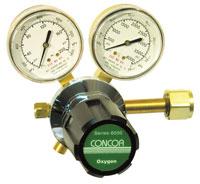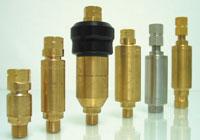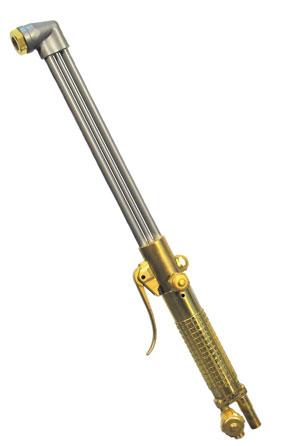Application Specialist
- FMA
- The Fabricator
- FABTECH
- Canadian Metalworking
Categories
- Additive Manufacturing
- Aluminum Welding
- Arc Welding
- Assembly and Joining
- Automation and Robotics
- Bending and Forming
- Consumables
- Cutting and Weld Prep
- Electric Vehicles
- En Español
- Finishing
- Hydroforming
- Laser Cutting
- Laser Welding
- Machining
- Manufacturing Software
- Materials Handling
- Metals/Materials
- Oxyfuel Cutting
- Plasma Cutting
- Power Tools
- Punching and Other Holemaking
- Roll Forming
- Safety
- Sawing
- Shearing
- Shop Management
- Testing and Measuring
- Tube and Pipe Fabrication
- Tube and Pipe Production
- Waterjet Cutting
Industry Directory
Webcasts
Podcasts
FAB 40
Advertise
Subscribe
Account Login
Search
Wading through the NFPA-51 standard
Create a safe, reliable oxyfuel environment
- By John Karpus
- January 17, 2011
- Article
- Safety

Be sure to protect industrial oxygen equipment, such as regulators, from oil, grease, hydrocarbons, or other flammable substances.
Years of industry experience has resulted in the evolution of safe and reliable oxyfuel cutting, welding, and heating equipment. Mandates for such procedures are formally spelled out by the National Fire Protection Association’s NFPA 51 standard, which applies to the design and installation of oxygen fuel gas welding and cutting systems and allied processes.
An authoritative source on public safety dedicated to reducing the burden of fire and other hazards through consensus codes and standards, research, training, and education, the NFPA provides more than 300 consensus codes and standards intended to minimize the possibility and effects of fire and other risks. The NFPA 51 standard outlines how to store, transfer, and use industrial gases properly; how to handle such gases while they are in their gaseous and liquid phases; and how to implement storage, piping and distribution, and operating practices. While most safe practices are based on common sense, others may take volumes of technical reference, as specified in NFPA 51, to explain.
Handling Gas Cylinders
Accidents typically occur when gas equipment is improperly installed, maintained, or used. Observing safety requirements starts at the product source. Knowing the correct gas for the application is essential.
Gas cylinders should always be fastened securely to a wall, stand, or cart to keep them from being knocked over. The fasteners must be of a nonflammable material, and in some states, two sets of restraining straps are required on each cylinder. California is one such state that requires double restraining straps because of earthquakes.
When using compressed-gas cylinders, except in the case of fuel gases, turn the valve away from you before attaching the regulator or manifold pigtail to the cylinder valve. Also, open it slightly and then close it to remove loose dirt and contaminants that could get into the regulator or inlet fitting and compromise its performance. Depending on where you live, it’s not uncommon to find things like hornet nests inside cylinder caps and cylinder valves.
The cylinder valve opening and the regulator inlet nipple should always be shiny and clean inside and out. This is particularly important in oxygen service. Oil, grease, or any hydrocarbon (WD-40) in the presence of pure oxygen is flammable or explosive. Always keep a pure oxygen source away from oil, grease, hydrocarbons, and other flammable substances.
After installing the regulator onto the cylinder but before opening the cylinder valve, make sure the adjusting knob or T handle on the regulator is in the off position, or backed out in the counterclockwise position.
The cylinder valve should be rotated slowly to the on position to prevent damage to the regulator from adiabatic compression, heat resulting from recompression ignition. It’s also prudent never to stand in front of or in back of a regulator when opening the cylinder valve. Always stand with the cylinder between you and the regulator.
When the application requires a manifold, most suppliers have gone to stainless steel or MONEL®-lined pigtails in oxygen service to minimize the potential of a fire from the same heat of recompression. With Teflon®-lined pigtails, a heat sink accumulator is often installed to prevent adiabatic compression.
Once the inlet gauge reading stops rising, open the oxygen cylinder valve all the way. Most fuel gas cylinders should be opened only 1 to 11⁄2 turns, and preferably no more than 3⁄4 of a turn, which gives you the ability to shut off the fuel gas source quickly in case of an emergency (see Figure 1).
Fuel Hoses
Red/green twin line oxyfuel hoses are one of the least expensive but often the most overlooked components in a welding or cutting application. Correct hose material is required for different fuel gases. One hose does not fit all applications. A quick test to check if your hose needs replacing is to take the twin hose in hand and double it back on itself, creating a pinch. If you see any sign of cracking, thinning, or wear, discard the hose and replace it with a new one.
Never repair a hose with tape, and avoid splicing. Always use the shortest possible length of hose. Extra length creates pressure drop at the torch and also makes available more explosive oxyfuel for a potential accident should a hot piece of slag drop and burn through the hose. Test gauges are available to help correct pressure drop through this line-loss dynamic.
Twin hoses are available in several grades, depending on your choice of fuel gas. Always make sure you are using the correct hose grade for your application.
Torches and Tips
Select torches and tips that are rated for the demands of the application. Choosing the incorrect tip size can result in a flashback. Correctly located flashback arresters in the gas delivery system are critical. Never use oxyfuel regulators or torches without flashback arrester protection. The NFPA requires visual and bubble leak tests be performed on oxyfuel cutting and welding torch setups prior to use.
The same rules of torch safety apply to heating or rosebud applications. The critical issue with this application is to supply the heating head with enough fuel gas. All fuel gases that come from a liquid product have a vapor rate that is affected by temperature and the wetted surface area inside the cylinder. Using a heating head with a fuel gas cylinder half full or almost empty or in cold temperatures will affect its performance. The flame on a heating head must always be off the end of the tip (see Figure 2).
Gas Storage, Delivery
The NFPA 51 standard references three separate cylinder storage requirements along with fabrication and marking designation. The main issue is protecting all cylinders by placing them at least 25 ft. away from flammable or combustible materials or conditions. It also is important to isolate them in such a way to keep them from being tampered with by unauthorized personnel. Electrical outlets or any electrical source that could ignite a flammable gas leak must also be isolated by 25 ft. when flammable gases are stored in the same area.
Industry standards approximate the time it takes to change out empty compressed-gas cylinders at 20 minutes. Rather than having a set of gas cylinders at each workstation, you may benefit from installing gas manifolds and station drops to deliver gas. This increases efficiency and reduces lost time from cylinder changeouts.
Manifolds are either plumbed in a dead-end or a looped configuration. A dead-end system will terminate at the last drop, whereas a looped system will be connected from the last drop back to where the manifold originates. The dead-end system often has problems starving the last legs of the manifold system when demand or draw on the gas product increases.
About the Author
John Karpus
1501 Harpers Road
Virginia Beach, VA 23454
800-225-0473
About the Publication
subscribe now

The Welder, formerly known as Practical Welding Today, is a showcase of the real people who make the products we use and work with every day. This magazine has served the welding community in North America well for more than 20 years.
start your free subscription- Stay connected from anywhere

Easily access valuable industry resources now with full access to the digital edition of The Fabricator.

Easily access valuable industry resources now with full access to the digital edition of The Welder.

Easily access valuable industry resources now with full access to the digital edition of The Tube and Pipe Journal.
- Podcasting
- Podcast:
- The Fabricator Podcast
- Published:
- 04/16/2024
- Running Time:
- 63:29
In this episode of The Fabricator Podcast, Caleb Chamberlain, co-founder and CEO of OSH Cut, discusses his company’s...
- Trending Articles
Sheffield Forgemasters makes global leap in welding technology

Welding student from Utah to represent the U.S. at WorldSkills 2024

Lincoln Electric announces executive appointments

Engine-driven welding machines include integrated air compressors

ESAB unveils Texas facility renovation

- Industry Events
16th Annual Safety Conference
- April 30 - May 1, 2024
- Elgin,
Pipe and Tube Conference
- May 21 - 22, 2024
- Omaha, NE
World-Class Roll Forming Workshop
- June 5 - 6, 2024
- Louisville, KY
Advanced Laser Application Workshop
- June 25 - 27, 2024
- Novi, MI




























